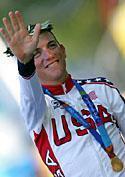News analysis, November 6, 2004
How Tyler's medal was saved
WADA's Independent Observers Report raises questions
By Jeff Jones

|
The World Anti-Doping Agency's (WADA) Independent Observers Report on the anti-doping methods used at the Athens Olympics has shed more light on the events that allowed Tyler Hamilton to keep the gold medal that he won in the individual time trial, despite an "adverse analytical finding" in one of his blood samples. Hamilton's A sample was declared positive for blood transfusion, but his B sample was accidentally frozen, meaning that it couldn't be analysed. For an athlete to test positive under IOC/WADA rules, both their A and B samples need to be positive.
Although Hamilton did return A and B positive samples at the Vuelta a month later, the WADA IO report only focused on the Olympic test. The sample, taken on August 19, was analysed at the Athens Doping Control Laboratory (DCL) and an analysis report signed by the lab director on August 22 registered the A sample as negative, but with an annotation stating that the sample was "suspicious for a blood transfusion." Once the Medical Director of the IOC was informed of this, he decided to take no further action. The B sample was subsequently frozen, and the case would have ended there had not the WADA Science Director become involved.
After a discussion between the IOC's Medical Director, the WADA Science Director and the President of the IOC, the case was reviewed by a panel of external experts between September 9 and 16. The review "resulted in a decision on 16 September 2004 to designate the sample as positive." Hamilton was informed of this on the same day, and given the opportunity to have the B sample analysed in Lausanne. He requested this, but the B sample had been frozen and there weren't enough red blood cells to perform the analysis. It was at this point, on September 21, that the IOC decided that it "will not be pursuing sanctions regarding this matter."
The IOC's decision didn't satisfy the Russian Olympic Committee, which lodged an appeal to the Court of Arbitration for Sport in October to try to strip Hamilton of his medal. The Russian Olympic Committee wants the gold medal to go to Viatcheslav Ekimov, who was second in Athens. The appeal is being backed by the Australian Olympic Committee, because Michael Rogers placed fourth in the time trial and could move into the bronze medal if Hamilton is DQ'd.
Lab not confident
The impression from reading this part of the IO report is that the Athens DCL did not possess the competence to use the Australian-developed test to detect homologous blood transfusions. Even the storage protocol for blood samples was either ignored or misunderstood, according to the report. The observers were critical in their findings:
"It is apparent that a series of errors and/or misunderstandings have occurred such that an A-sample that was originally declared negative but later positive was ultimately unable to have been acted upon...There is always a risk, when new methodologies are fast tracked, that problems relating to the very newness of a process will occur. This certainly appears to be the case here. A series of compounding misunderstandings or errors meant that a situation that might have been able to be retrieved at a number of points was ultimately lost and, depending on one's perspective, either an athlete that engaged in doping practices was able to escape or an innocent athlete was unfairly implicated in doping."
The IO report did praise the "honest endeavour and honourable intent of all the key players involved" but noted the lab's "lack of confidence in the laboratory's general ability to meet the criteria for "flexible accreditation" necessary to make a valid report rather than the lack of a clear analytical result."
The report also questioned why the Chair of the IOC Medical Commission wasn't involved from the beginning, when it was clear that this could have been the first case of an alleged blood transfusion. "Nothing provided to the IO Team indicates that he was involved at any critical point despite the Doping Control Guide establishing that result review was primarily his responsibility."
The 15 day delay between the communication between the IOC and WADA and the follow-up action on the A sample's analysis was cause for concern, as was the change declaring the sample negative to declaring it positive. The IO team stated that "re-examination of the technical data re-affirmed the view of the original expert group that the sample was in fact positive."
In summing up, WADA's IO report on the botched Hamilton case stated, "The exact circumstances of this case are unlikely to be replicated in the future, but it is not inconceivable that comparable situations may arise. It is clearly desirable that any predictable flaw in the system is eliminated and, to the extent that a deeper investigation into this case would assist that, the IOC is invited to consider organising such an investigation.
"The status of a laboratory with respect to its accreditation to provide a valid report for any particular substance must be clear prior to the initiation of analysis of any sample...Laboratory 'Reports of Analysis' should only refer to outcomes of tests that can be validated by the laboratory concerned. There should be no place for ambivalence in this respect on such reports."
The full WADA IO report is at: www.wada-ama.org/docs/web/communications/publications/reports/athensioreport.pdf
Tyler's next battle
Since the Athens lab debacle, there have been two more positive cases involving homologous blood transfusions. The first involves Hamilton again, after both his A and B samples taken on September 13 were declared positive; this time after being analysed in the UCI's anti-doping laboratory in Lausanne. The US Anti-Doping Agency is examining the second Hamilton case, and the initial hearing is expected next January.
The second case concerns Hamilton's trade teammate from Phonak, Santiago Perez, who was tested out of competition on October 5, following his amazing second place in the Vuelta a España and subsequent non-participation in the World Championships. Both Perez's A and B samples also showed signs of a blood transfusion, and his case is now being examined by the Spanish Cycling Federation. Both Hamilton and Perez have strenuously denied that they ever had a blood transfusion, and Phonak has convened its own panel of experts to critique the testing method, although what effect this will have on the disciplinary procedures is unknown.
According to L'Equipe, Hamilton was informed of irregular blood values on two occasions earlier this season: at the Tour de Romandie in May (which he won) and at the Dauphiné Libéré in June. These were before the transfusion blood test was introduced, thus they were merely warnings from the UCI that Hamilton's blood did not look normal. No sanctions, even the 15 day suspension for a high hematocrit, could be dealt out for such irregularities.

|
Hamilton now faces the USADA, and has vowed to fight to "every last euro" to clear his name. But he won't have to spend just his own money, as his supporters have rallied to his defence via the believetyler.org website, which last week had raised US$35,000 as a small contribution to his legal fees. These could be considerable, as Hamilton has engaged Howard Jacobs as his lawyer. Jacobs specialises in sports defence cases, and is also defending US track sprinter Tim Montgomery in the BALCO case currently up in front of the Court of Arbitration for Sport.
As the UCI and WADA are unwilling to divulge any of Hamilton's test reports, his defence could take some time. He is now 33 years old, and if found guilty of blood doping, he risks a career ending ban of two years. But if his defence can manage to stall long enough, then the ban may be a moot point.
Related stories
Spanish
federation starts process against Perez, November 4, 2004
Phonak
confirms Perez positive, November 1, 2004
Santi
Perez positive for blood transfusion?, October 30, 2004
Russians
appeal Hamilton's gold, October 21, 2004
Pound
on Hamilton, October 1, 2004
In the blood - How the new
blood doping test works, September 23, 2004
Hamilton
suspended by Phonak, September 22, 2004
Hamilton
and Phonak protest innocence, September 22, 2004
Hamilton
fails blood tests, September 21, 2004
Anti-doping
measures get tougher - Tour de France announces new tests, July 3, 2004

